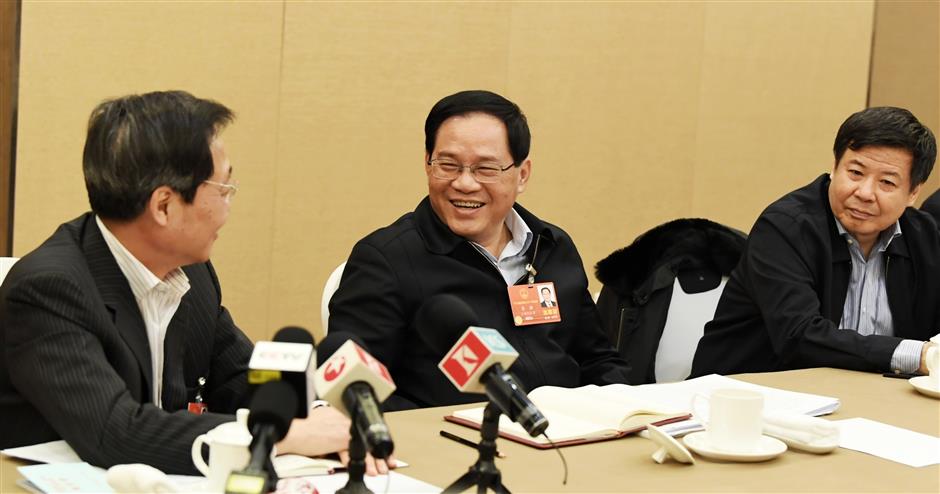Wish list of the Shanghai deputies

Shanghai’s Party Secretary Li Qiang (center) joins a panel discussion of the Shanghai delegation yesterday during the first session of the 13th National People’s Congress in Beijing.
Shanghai and the other three provinces in the Yangtze River Delta region have put forward their proposals for regional integration in the delta.
Li Qiang, Party secretary of Shanghai, said the proposals also call for a setting up of a cooperative office to discuss regional cooperation issues.
A panel discussion of the Shanghai delegation to the first session of the 13th National People’s Congress was held yesterday.
Li said the Yangtze River Delta is one of China’s most active regions in the economy, with the highest openness level and the strongest ability in innovation.
It is also the key “joint” of the Belt and Road initiative and the Yangtze River Economic Belt, he said.
The economic aggregate of the three provinces — Jiangsu, Zhejiang and Anhui — along with Shanghai contributes to 23.7 percent of the country’s economy, Li said.
Currently, the Yangtze River Delta region has 12 special cooperation programs covering fields such as transport, industry and science. The quality of these cooperation projects will be further improved, Li said.
He called for a united market to be established in the Yangtze River Delta with public cooperation platforms that will push forward resource integration and boost the economy.
Besides the cooperative office, a three-year action plan will also be put in place, Li said.
Shanghai Mayor Ying Yong said the city has formed an Internet Plus Government Services “work frame.”
Currently, the city’s 220 community service centers all have their services available to be accessed online and 161 items relating to citizens’ livelihoods can be processed across the city.
Ying said that this year the city will push forward online approval of 90 percent of enterprise-related items requiring approval.
With regard to the first China International Import Expo to be held in Shanghai, Ying said it will be a world-class exhibition that will boost business, tourism and culture.
Shanghai’s construction of an international center for a trade and international consumption city, promoting Shanghai’s shopping brands, will be accelerated, the mayor added.
In a separate development, Tang Hailong, director of the city’s Chongming District, said the overall planning of Chongming by 2035 has entered a final process for submission for national approval.
Under the plan, the population won’t exceed the current size of 700,000, new construction will be confined to land already built upon, and the height of newly built structures will be no more than 18 meters.
Chongming aims to maximize its ecology credentials to boost tourism. The district’s cultural, medical and sports industries will also be promoted.
Chongming also aims to be the pioneer of ecological construction on behalf of Shanghai and a model development in the Yangtze River Economic Belt.
This year, the district will increase efforts to replace chemical fertilizers and pesticides with organic substitutes.
Meanwhile, Wu Guanghui, vice president of COMAC, the Shanghai-based company making the C919 — China’s home-built large passenger plane — said the second prototype is now undergoing a refitting in Shanghai.
The plane is set to have a test flight to Shandong Province next month. It will also undergo further systems tests, Wu said.
So far two C919s have been produced, and a third will have its first flight from the Shanghai Pudong International Airport’s newly built fifth runway before the end of this year.
A total of six C919 planes are due to join test flights.
















